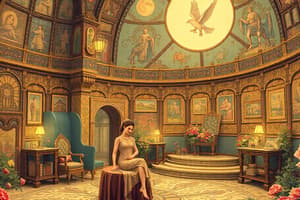Podcast
Questions and Answers
What is aliteration?
What is aliteration?
- A stylistic literary device with repeated sound of the first consonant. (correct)
- The repetition of a certain word at the beginning of lines.
- A figure of speech that compares two unlike things.
- An extreme exaggeration used for emphasis.
What is the definition of hyperbole?
What is the definition of hyperbole?
An extreme exaggeration used to make a point.
Define metaphor.
Define metaphor.
A figure of speech that identifies something as being the same as some unrelated thing.
What does onomatopoeia refer to?
What does onomatopoeia refer to?
What is personification?
What is personification?
What does simile involve?
What does simile involve?
What is anaphora?
What is anaphora?
Define antithesis.
Define antithesis.
What is an apostrophe in literature?
What is an apostrophe in literature?
Define circumlocution.
Define circumlocution.
What is enumeration?
What is enumeration?
What is a euphemism?
What is a euphemism?
In a scale, we say first ____ then ____.
In a scale, we say first ____ then ____.
Define hyperbaton.
Define hyperbaton.
What does asíndeton mean?
What does asíndeton mean?
What is cacophony?
What is cacophony?
What is an epithet?
What is an epithet?
What is metonymy?
What is metonymy?
Define paradox.
Define paradox.
What is polysyndeton?
What is polysyndeton?
What is synecdoche?
What is synecdoche?
What is synesthesia?
What is synesthesia?
Define retruécano.
Define retruécano.
Flashcards
Alliteration
Alliteration
Repetition of initial consonant sounds in a series of words.
Hyperbole
Hyperbole
Extreme exaggeration for emphasis.
Metaphor
Metaphor
Describes one thing as another, without "like" or "as".
Onomatopoeia
Onomatopoeia
Signup and view all the flashcards
Personification
Personification
Signup and view all the flashcards
Simile
Simile
Signup and view all the flashcards
Anaphora
Anaphora
Signup and view all the flashcards
Antithesis
Antithesis
Signup and view all the flashcards
Apostrophe
Apostrophe
Signup and view all the flashcards
Ellipsis
Ellipsis
Signup and view all the flashcards
Enumeration
Enumeration
Signup and view all the flashcards
Euphemism
Euphemism
Signup and view all the flashcards
Gradation
Gradation
Signup and view all the flashcards
Hyperbaton
Hyperbaton
Signup and view all the flashcards
Asyndeton
Asyndeton
Signup and view all the flashcards
Cacophony
Cacophony
Signup and view all the flashcards
Epithet
Epithet
Signup and view all the flashcards
Metonymy
Metonymy
Signup and view all the flashcards
Paradox
Paradox
Signup and view all the flashcards
Polysyndeton
Polysyndeton
Signup and view all the flashcards
Synecdoche
Synecdoche
Signup and view all the flashcards
Circumlocution
Circumlocution
Signup and view all the flashcards
Study Notes
Aliteration
- A stylistic device characterized by the repetition of the same initial consonant sound in a series of words.
- Example: "Allen ate apples awkwardly."
Hyperbole
- An intentional and extreme exaggeration used to emphasize a point.
- Example: "I literally died."
Metaphor
- A figure of speech that asserts that one thing is another, highlighting similarities without using "like" or "as."
- Example: "Freddie is a pig when he eats."
Onomatopoeia
- The use of words that phonetically imitate or suggest the sound they describe.
- Example: "Boo!"
Personification
- Attributing human qualities to animals, objects, or abstract ideas.
- Example: "The fire ran wild."
Simile
- A comparison between two different things using "like" or "as" for emphasis and vividness.
- Example: "I'm as brave as a lion."
Anaphora
- The repetition of a word or phrase at the beginning of successive sentences or lines for rhetorical effect.
- Example: "I have a dream that..."
Antithesis
- A device that contrasts two opposing ideas for a striking effect.
- Example: "That's one small step for man, one giant leap for mankind."
Apostrophe
- A literary device addressing a person or entity not present in the conversation.
- Example: "Twinkle twinkle little star, how I wonder what you are..."
Circumlocution (or Periphrasis)
- An indirect, wordy way of expressing an idea, often used to avoid precision.
- Describes elaborate imagery, as in describing a jungle or conditions of the land.
Ellipsis
- The omission of a word or series of words that is understood in context, often indicated by three dots (...).
Enumeration
- A complete and organized listing of items in a collection.
- Example: "Get eggs, rice, cheese, butter, and milk please."
Euphemism
- A milder or softer term used to replace a harsh or blunt one regarding unpleasant topics.
- Example: "Passed away" instead of "died."
Gradation
- A scale or sequence in which elements are arranged in order of increasing significance or intensity.
Hyperbaton
- An inversion of the normal word order in a sentence for emphasis.
- Example: "This I must see."
Asyndeton
- The deliberate omission of conjunctions between parts of a sentence to speed up the rhythm.
- Example: "I came, I saw, I conquered."
Cacophony
- The use of harsh, discordant sounds in language, primarily through consonants.
- Example from a Lewis Carroll poem.
Epitheton
- A descriptive adjective or phrase that characterizes a person or thing.
- Example: "Sailing across the wine-dark sea."
Metonymy
- A figure of speech where a thing is referred to by the name of an associated concept.
- Example: "Friends, Romans, countrymen, lend me your ears."
Paradox
- A statement that contradicts itself but may still hold truth.
- Example: "I must be cruel to be kind."
Polysyndeton
- The use of multiple conjunctions where they could be omitted, to create a sense of multiplicity.
- Example: "He ran and jumped and laughed for joy."
Synecdoche
- A figure of speech where a part of something represents the whole, or vice versa.
- Example: "She organized her life around the little yellow ball."
Synesthesia
- A literary technique where writers evoke sensory experiences that appeal to multiple senses simultaneously.
- Example: Descriptions of colors in relation to words and sensations.
Retruécano
- A form of wordplay or pun that exploits similar-sounding words for humorous effect.
- Example: "The two pianists had a good marriage. They always were in a chord."
Studying That Suits You
Use AI to generate personalized quizzes and flashcards to suit your learning preferences.




